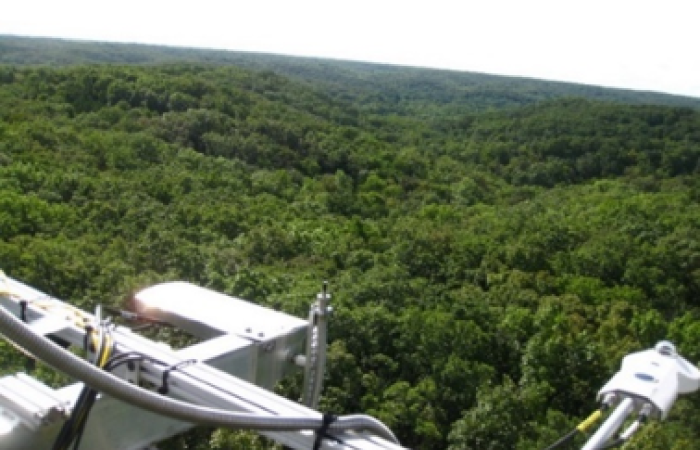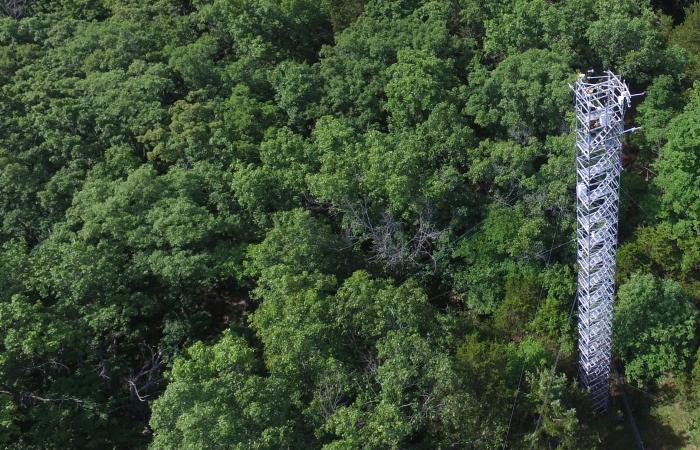-

The FAME platform developed by ORNL, shown here deployed at the Ameriflux observation site in Missouri, measures solar-induced fluorescence, a key marker of photosynthesis and plant health. Credit: Lianhong Gu/ORNL, U.S. Dept. of Energy
-

The Ameriflux observation tower in Missouri is where ORNL scientists installed the FAME platform, an instrument that monitors plant productivity and health over a wide area. Credit: Jeffrey Wood/University of Missouri
-

The FAME platform developed by ORNL, shown here deployed at the Ameriflux observation site in Missouri, measures solar-induced fluorescence, a key marker of photosynthesis and plant health. Credit: Lianhong Gu/ORNL, U.S. Dept. of Energy
-

The Ameriflux observation tower in Missouri is where ORNL scientists installed the FAME platform, an instrument that monitors plant productivity and health over a wide area. Credit: Jeffrey Wood/University of Missouri
Technology developed at the Department of Energy's Oak Ridge National Laboratory to monitor plant productivity and health at wide scales has been licensed to Logan, Utah-based instrumentation firm Campbell Scientific Inc.
The technology measures solar-induced fluorescence, or SIF, which is emitted by plants during photosynthesis as they convert sunlight into chemical energy. ORNL's Fluorescence Auto-Measurement Equipment, or FAME, platform uses a high-resolution spectrometer, a data logger, supporting devices and sensors, and a novel algorithm to analyze spectrum data to determine SIF levels across a wide area.
Licensed non-exclusively to Campbell Scientific for commercial production, FAME monitors plant productivity and health by measuring this important photosynthesis indicator. It can, for instance, provide insight into forests and croplands that may be stressed by drought or excessive heat. It also helps scientists discern how much carbon dioxide is being absorbed by plants as they study the planet's carbon cycle and climate change.
The platform was first developed and deployed by ORNL's Lianhong Gu and colleagues at the Missouri Ozark Ameriflux site, a DOE-supported experimental station where scientists use instruments on a 106-foot tower to measure carbon, water and energy balance in the region's oak-hickory forests. FAME has been added to the DOE SPRUCE peatlands experimental site led by ORNL in northern Minnesota, and will soon be installed at DOE environmental research project sites in Brazil and Alaska.
"I'm excited to see this new instrument go into commercial use," said Gu, an ORNL Distinguished Scientist. "It is important to understand the productivity and health of our natural and managed ecosystems in response to environmental conditions. This is the first step of the carbon cycle. We also want to get quality data into our modern Earth modeling systems to better assess and predict the future of our planet's climate. If we can get the first step of the carbon cycle right, then we can get the downstream impacts right."
Larry Jacobsen, principal engineer at Campbell Scientific sees the licensing agreement benefiting plant physiologists, climate scientists and carbon-cycle modelers.
"The SIF measurements, when combined with the traditional, direct measure of CO2 uptake using our eddy-covariance systems, promises to enhance spatial and temporal coverage of carbon-cycle measurements. The licensed SIF technology matches our commitment to quality manufacturing and exceptional customer support. We are pleased that Dr. Gu chose a Campbell data logger, our core product line for over 40 years, on which to develop his SIF system."
"This is another example of ORNL breaking new ground by developing a specialized instrument to provide measurements and data to advance ecosystem research in support of our scientific mission," said Eric Pierce, director of ORNL's Environmental Sciences Division.
Stan Wullschleger, associate laboratory director for Biological and Environmental Systems Science at ORNL, said, "Technology like this can provide unique insights into how forests and other ecosystems respond to extreme weather events like droughts, heat waves and even consequences due to insects and disease."
Gu and colleague Jeffrey Riggs are the platform inventors. The research is supported by the DOE Office of Science's Biological and Environmental Research program.






